Small Cell Transformation of EGFR-Mutant NSCLC Treated with Tyrosine Kinase Inhibition
Simple Summary
Abstract
1. Introduction
2. Methods
3. Results
4. Discussion
5. Conclusions
Author Contributions
Funding
Institutional Review Board Statement
Informed Consent Statement
Data Availability Statement
Conflicts of Interest
References
- Bray, F.; Laversanne, M.; Sung, H.; Ferlay, J.; Siegel, R.L.; Soerjomataram, I.; Jemal, A. Global cancer statistics 2022: GLOBOCAN estimates of incidence and mortality worldwide for 36 cancers in 185 countries. CA A Cancer J. Clin. 2024, 74, 229–263. [Google Scholar] [CrossRef]
- Niederst, M.J.; Sequist, L.V.; Poirier, J.T.; Mermel, C.H.; Lockerman, E.L.; Garcia, A.R.; Katayama, R.; Costa, C.; Ross, K.N.; Moran, T.; et al. RB loss in resistant EGFR mutant lung adenocarcinomas that transform to small-cell lung cancer. Nat. Commun. 2015, 6, 6377. [Google Scholar] [CrossRef]
- Sequist, L.V.; Waltman, B.A.; Dias-Santagata, D.; Digumarthy, S.; Turke, A.B.; Fidias, P.; Bergethon, K.; Shaw, A.T.; Gettinger, S.; Cosper, A.K.; et al. Genotypic and Histological Evolution of Lung Cancers Acquiring Resistance to EGFR Inhibitors. Sci. Transl. Med. 2011, 3, 75ra26. [Google Scholar] [CrossRef] [PubMed]
- Awad, M.M.; Liu, S.; Rybkin, I.I.; Arbour, K.C.; Dilly, J.; Zhu, V.W.; Johnson, M.L.; Heist, R.S.; Patil, T.; Riely, G.J.; et al. Acquired Resistance to KRAS(G12C) Inhibition in Cancer. N. Engl. J. Med. 2025, 384, 2382–2393. [Google Scholar] [CrossRef] [PubMed]
- Caumont, C.; Veillon, R.; Gros, A.; Laharanne, E.; Bégueret, H.; Merlio, J.-P. Neuroendocrine phenotype as an acquired resistance mechanism in ALK-rearranged lung adenocarcinoma. Lung Cancer 2016, 92, 15–18. [Google Scholar] [CrossRef]
- Cha, Y.J.; Cho, B.C.; Kim, H.R.; Lee, H.-J.; Shim, H.S. A Case of ALK-Rearranged Adenocarcinoma with Small Cell Carcinoma-Like Transformation and Resistance to Crizotinib. J. Thorac. Oncol. 2016, 11, e55–e58. [Google Scholar] [CrossRef]
- Lin, J.J.; Langenbucher, A.; Gupta, P.; Yoda, S.; Fetter, I.J.; Rooney, M.; Do, A.; Kem, M.; Chang, K.P.; Oh, A.Y.; et al. Small cell transformation of ROS1 fusion-positive lung cancer resistant to ROS1 inhibition. npj Precis. Oncol. 2020, 4, 21. [Google Scholar] [CrossRef]
- Wu, C.; Su, P.; Hsu, C.; Chu, C.; Lin, C. Small cell transformation in crizotinib-resistantROS1-rearranged non-small cell lung cancer with retention ofROS1fusion: A case report. Thorac. Cancer 2021, 12, 3068–3071. [Google Scholar] [CrossRef]
- Yamagata, A.; Yokoyama, T.; Fukuda, Y.; Ishida, T. Alectinib re-challenge in small cell lung cancer transformation after chemotherapy failure in a patient with ALK-positive lung cancer: A case report. Respir. Med. Case Rep. 2021, 33, 101440. [Google Scholar] [CrossRef]
- Imakita, T.; Fujita, K.; Kanai, O.; Terashima, T.; Mio, T. Small cell lung cancer transformation during immunotherapy with nivolumab: A case report. Respir. Med. Case Rep. 2017, 21, 52–55. [Google Scholar] [CrossRef]
- Mariniello, A.; Righi, L.; Morrone, A.; Carnio, S.; Bironzo, P. Squamous cell histological transformation in a lung adenocarcinoma patient (hyper) progressing upon immunotherapy. Tumori J. 2022, 108, NP15–NP19. [Google Scholar] [CrossRef]
- Nagasaka, M.; Pansare, R.S.; Abdulfatah, E.; Guan, H.; Tranchida, P.; Gadgeel, S.M. Histologic Transformation in NSCLC with PD-1 therapy. J. Thorac. Oncol. 2017, 12, e133–e134. [Google Scholar] [CrossRef][Green Version]
- Miyoshi, Y.; Uemura, H.; Kitami, K.; Satomi, Y.; Kubota, Y.; Hosaka, M. Neuroendocrine differentiated small cell carcinoma presenting as recurrent prostate cancer after androgen deprivation therapy. BJU Int. 2001, 88, 982–983. [Google Scholar] [CrossRef] [PubMed]
- Yang, G.; Bondaruk, J.; Cogdell, D.; Wang, Z.; Lee, S.; Lee, J.G.; Zhang, S.; Choi, W.; Wang, Y.; Liang, Y.; et al. Urothelial-to-Neural Plasticity Drives Progression to Small Cell Bladder Cancer. iScience 2020, 23, 101201. [Google Scholar] [CrossRef] [PubMed]
- Huang, Y.; Jiang, X.; Liang, X.; Jiang, G. Molecular and cellular mechanisms of castration resistant prostate cancer (Review). Oncol. Lett. 2018, 15, 6063–6076. [Google Scholar] [CrossRef] [PubMed]
- Yu, H.A.; Arcila, M.E.; Rekhtman, N.; Sima, C.S.; Zakowski, M.F.; Pao, W.; Kris, M.G.; Miller, V.A.; Ladanyi, M.; Riely, G.J. Analysis of Tumor Specimens at the Time of Acquired Resistance to EGFR-TKI Therapy in 155 Patients with EGFR-Mutant Lung Cancers. Clin. Cancer Res. 2013, 19, 2240–2247. [Google Scholar] [CrossRef]
- Zhang, S.-L.; Zhang, C.-Y.; Chen, Y.-Q.; Li, Y.-F.; Xie, Z.; Zhang, X.-C.; Zhou, Q.; Zhong, W.-Z.; Huang, J.; Sun, H.; et al. Expression of EGFR-mutant proteins and genomic evolution in EGFR-mutant transformed small cell lung cancer. J. Thorac. Dis. 2023, 15, 4620–4635. [Google Scholar] [CrossRef]
- Marcoux, N.; Gettinger, S.N.; O’kAne, G.; Arbour, K.C.; Neal, J.W.; Husain, H.; Evans, T.L.; Brahmer, J.R.; Muzikansky, A.; Bonomi, P.D.; et al. EGFR-Mutant Adenocarcinomas That Transform to Small-Cell Lung Cancer and Other Neuroendocrine Carcinomas: Clinical Outcomes. J. Clin. Oncol. 2019, 37, 278–285. [Google Scholar] [CrossRef]
- Offin, M.; Chan, J.M.; Tenet, M.; Rizvi, H.A.; Shen, R.; Riely, G.J.; Rekhtman, N.; Daneshbod, Y.; Quintanal-Villalonga, A.; Penson, A.; et al. Concurrent RB1 and TP53 Alterations Define a Subset of EGFR-Mutant Lung Cancers at risk for Histologic Transformation and Inferior Clinical Outcomes. J. Thorac. Oncol. 2019, 14, 1784–1793. [Google Scholar] [CrossRef]
- Sivakumar, S.; Moore, J.A.; Montesion, M.; Sharaf, R.; Lin, D.I.; Colón, C.I.; Fleischmann, Z.; Ebot, E.M.; Newberg, J.Y.; Mills, J.M.; et al. Integrative Analysis of a Large Real-World Cohort of Small Cell Lung Cancer Identifies Distinct Genetic Subtypes and Insights into Histologic Transformation. Cancer Discov. 2023, 13, 1572–1591. [Google Scholar] [CrossRef]
- Pros, E.; Saigi, M.; Alameda, D.; Gomez-Mariano, G.; Martinez-Delgado, B.; Alburquerque-Bejar, J.; Carretero, J.; Tonda, R.; Esteve-Codina, A.; Catala, I.; et al. Genome-wide profiling of non-smoking-related lung cancer cells reveals common RB1 rearrangements associated with histopathologic transformation in EGFR-mutant tumors. Ann. Oncol. 2020, 31, 274–282. [Google Scholar] [CrossRef]
- Zhou, X.; Wang, X.; Zhu, H.; Gu, G.; Zhan, Y.; Liu, C.; Sun, G. PI3K inhibition sensitizes EGFR wild-type NSCLC cell lines to erlotinib chemotherapy. Exp. Ther. Med. 2020, 21, 9. [Google Scholar] [CrossRef] [PubMed]
- Fang, W.; Huang, Y.; Gu, W.; Gan, J.; Wang, W.; Zhang, S.; Wang, K.; Zhan, J.; Yang, Y.; Huang, Y.; et al. PI3K-AKT-mTOR pathway alterations in advanced NSCLC patients after progression on EGFR-TKI and clinical response to EGFR-TKI plus everolimus combination therapy. Transl. Lung Cancer Res. 2020, 9, 1258–1267. [Google Scholar] [CrossRef] [PubMed]
- Lara, P.N.; Longmate, J.; Mack, P.C.; Kelly, K.; Socinski, M.A.; Salgia, R.; Gitlitz, B.; Li, T.; Koczywas, M.; Reckamp, K.L.; et al. Phase II Study of the AKT Inhibitor MK-2206 plus Erlotinib in Patients with Advanced Non–Small Cell Lung Cancer Who Previously Progressed on Erlotinib. Clin. Cancer Res. 2015, 21, 4321–4326. [Google Scholar] [CrossRef] [PubMed]
- Grazini, U.; Markovets, A.; Ireland, L.; O’nEill, D.; Phillips, B.; Xu, M.; Pfeifer, M.; Vaclova, T.; Martin, M.J.; Bigot, L.; et al. Overcoming Osimertinib Resistance with AKT Inhibition in EGFRm-Driven Non–Small Cell Lung Cancer with PIK3CA/PTEN Alterations. Clin. Cancer Res. 2024, 30, 4143–4154. [Google Scholar] [CrossRef]
- Hayward, C.; Brock, D.J.H. Fibrillin-1 mutations in Marfan syndrome and other type-1 fibrillinopathies. Hum. Mutat. 1997, 10, 415–423. [Google Scholar] [CrossRef]
- Shu, X.; Chen, M.; Liu, S.Y.; Yu, L.; Sun, L.X.; Sun, L.C.; Ran, Y.L. Palladin promotes cancer stem cell-like properties in lung cancer by activating Wnt/Β-Catenin signaling. Cancer. Med. 2023, 12, 4510–4520. [Google Scholar] [CrossRef]
- El Zarif, T.; Meador, C.B.; Qiu, X.; Seo, J.-H.; Davidsohn, M.P.; Savignano, H.; Lakshminarayanan, G.; McClure, H.M.; Canniff, J.; Fortunato, B.; et al. Detecting Small Cell Transformation in Patients with Advanced EGFR Mutant Lung Adenocarcinoma through Epigenomic cfDNA Profiling. Clin. Cancer Res. 2024, 30, 3798–3811. [Google Scholar] [CrossRef]
- Saalfeld, F.C.; Möller, J.; Christopoulos, P.; Wenzel, C.; Rasokat, A.; Wang, X.A.; Vathiotis, I.; König, D.; Illini, O.; Grohé, C.; et al. Small cell transformation in EGFR-mutated non-small cell lung cancer: DLL3 expression and efficacy of immune checkpoint inhibitors or tyrosine kinase inhibitors combined with chemotherapy. Eur. J. Cancer 2024, 213, 115065. [Google Scholar] [CrossRef]
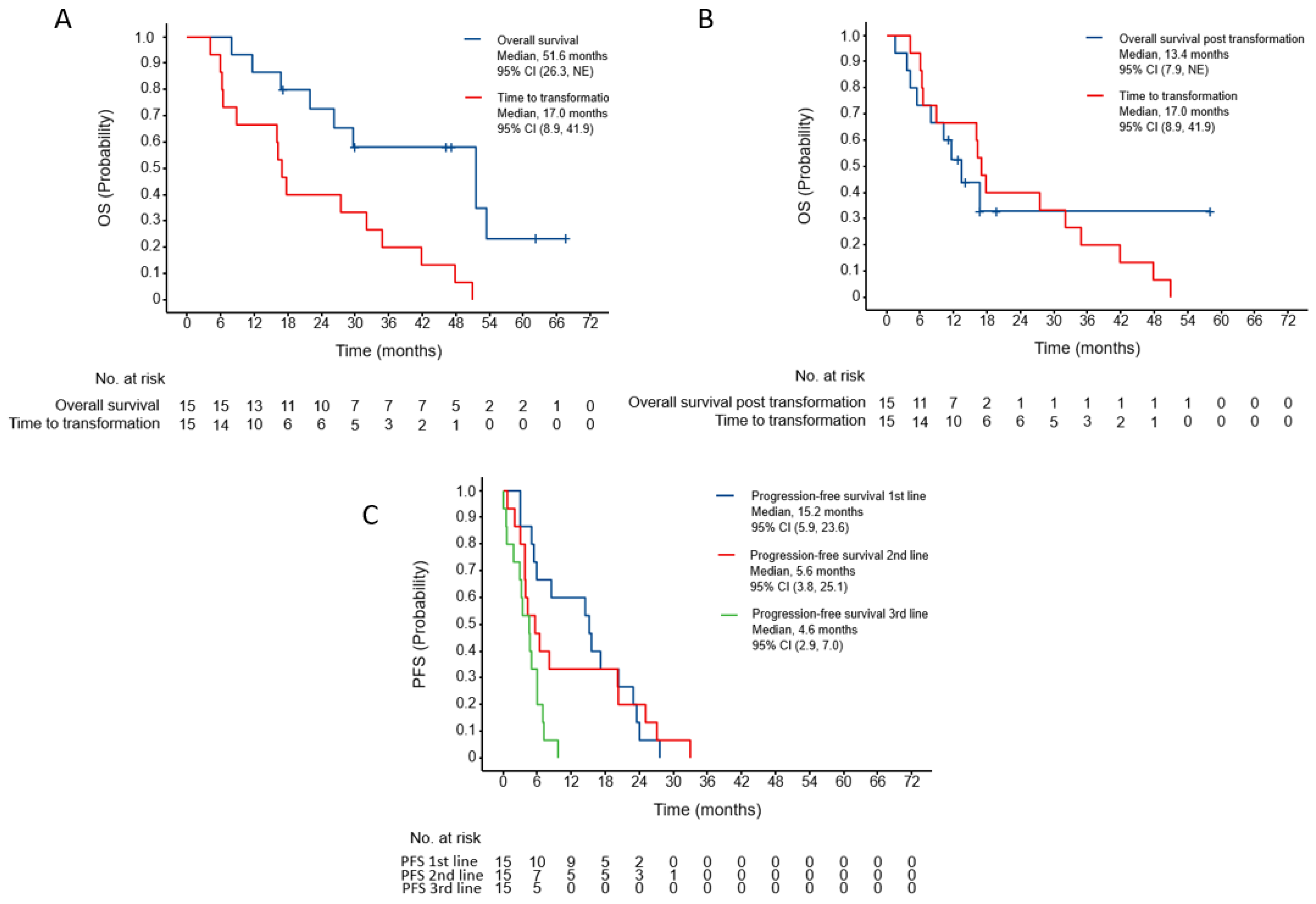
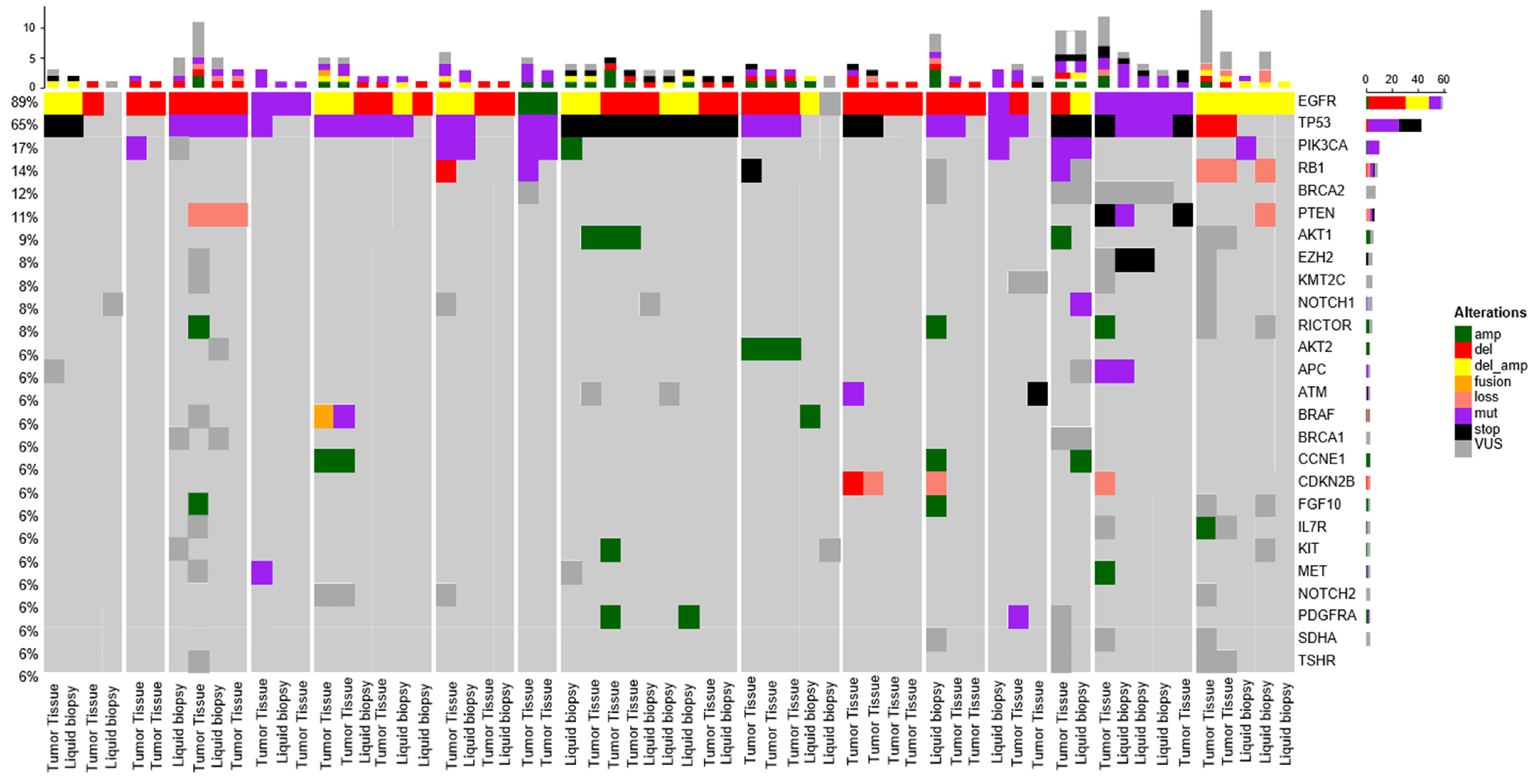
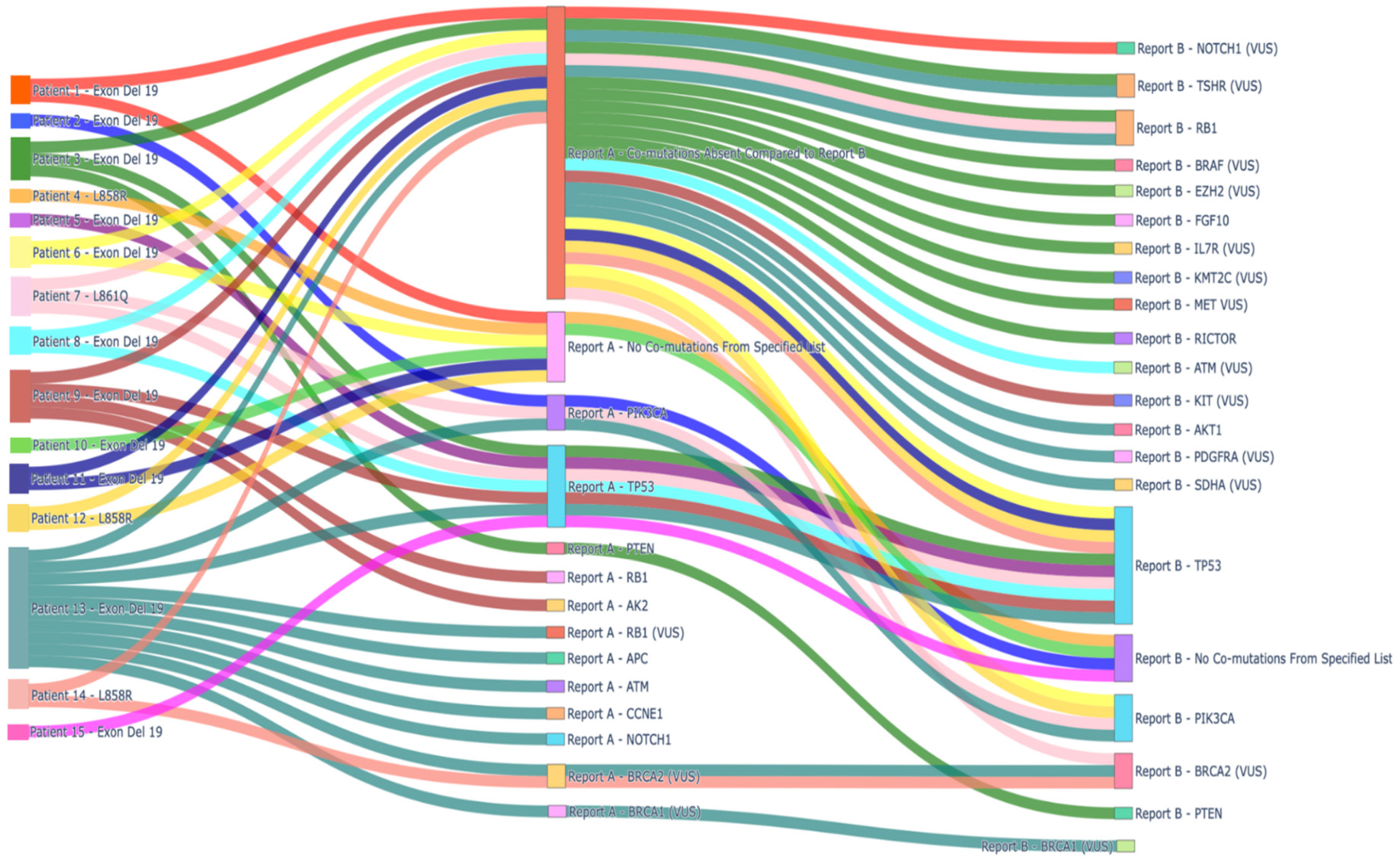
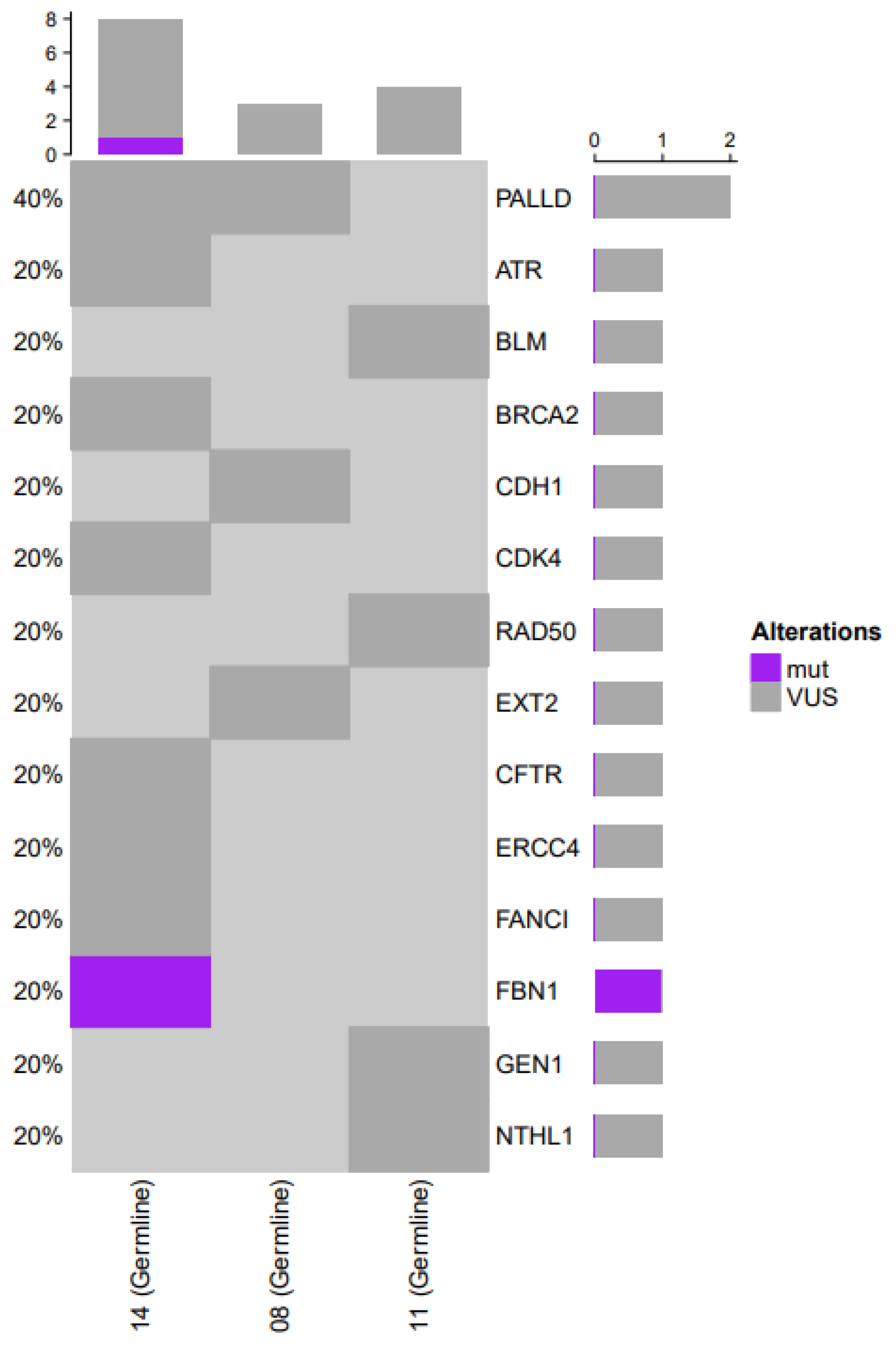
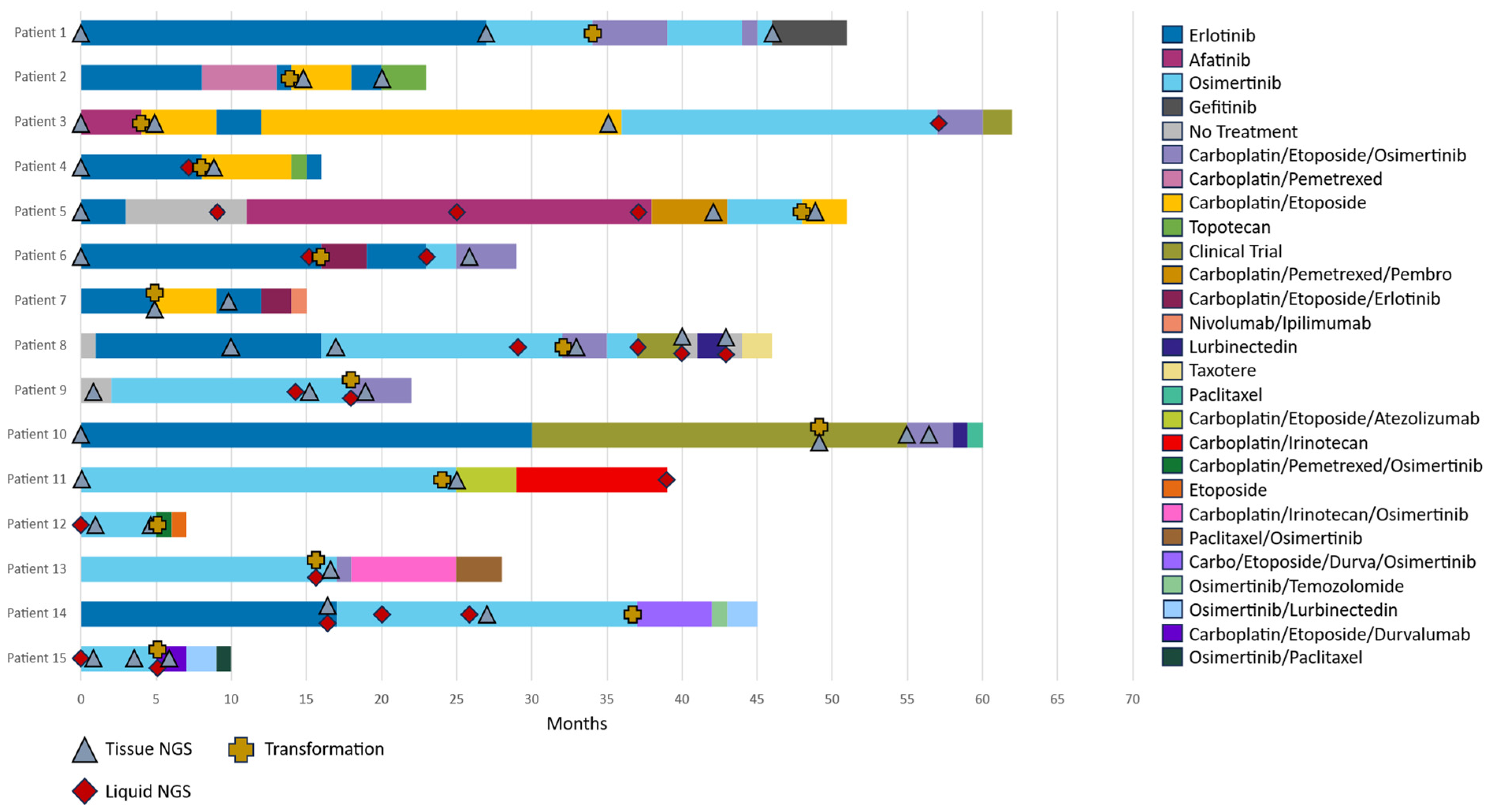
| Patient Characteristics | N (%) |
|---|---|
| Total enrolled patients, No. | 15 (100%) |
| Age, years, median (range) | 60.0 (35.0 72.0), IQR (54.5, 66.5) |
| Gender | |
| Female | 7 (46.7%) |
| Male | 8 (53.3%) |
| Race | |
| White/Caucasian | 6 (40%) |
| Asian | 9 (60%) |
| Ethnicity | |
| Hispanic or Latino | (0%) |
| Not Hispanic or Latino | 15 (100%) |
| Smoking status | |
| Former Smoker | 5 (33.3%) |
| Former; Passive Exposure | 1 (6.7%) |
| Never Smoker | 8 (53.3%) |
| Never Smoker; Passive Exposure | 1 (6.7%) |
| EGFR founder | |
| EGFR L858R mutation | 3 (20%) |
| EGFR Exon 19 deletion | 11 (73.3%) |
| EGFR L861Q mutation | 1 (6.7%) |
| Median line of therapy before transformation (range) | 1 (1–4) |
Disclaimer/Publisher’s Note: The statements, opinions and data contained in all publications are solely those of the individual author(s) and contributor(s) and not of MDPI and/or the editor(s). MDPI and/or the editor(s) disclaim responsibility for any injury to people or property resulting from any ideas, methods, instructions or products referred to in the content. |
© 2025 by the authors. Licensee MDPI, Basel, Switzerland. This article is an open access article distributed under the terms and conditions of the Creative Commons Attribution (CC BY) license (https://creativecommons.org/licenses/by/4.0/).
Share and Cite
Rock, A.; Mambetsariev, I.; Pareek, S.; Fricke, J.; Li, X.; Arias-Romero, J.; Kareem, W.; Arvanitis, L.; Bruno, D.S.; Gray, S.; et al. Small Cell Transformation of EGFR-Mutant NSCLC Treated with Tyrosine Kinase Inhibition. Curr. Oncol. 2025, 32, 554. https://doi.org/10.3390/curroncol32100554
Rock A, Mambetsariev I, Pareek S, Fricke J, Li X, Arias-Romero J, Kareem W, Arvanitis L, Bruno DS, Gray S, et al. Small Cell Transformation of EGFR-Mutant NSCLC Treated with Tyrosine Kinase Inhibition. Current Oncology. 2025; 32(10):554. https://doi.org/10.3390/curroncol32100554
Chicago/Turabian StyleRock, Adam, Isa Mambetsariev, Siddhika Pareek, Jeremy Fricke, Xiaochen Li, Javier Arias-Romero, Waasil Kareem, Leonidas Arvanitis, Debora S. Bruno, Stacy Gray, and et al. 2025. "Small Cell Transformation of EGFR-Mutant NSCLC Treated with Tyrosine Kinase Inhibition" Current Oncology 32, no. 10: 554. https://doi.org/10.3390/curroncol32100554
APA StyleRock, A., Mambetsariev, I., Pareek, S., Fricke, J., Li, X., Arias-Romero, J., Kareem, W., Arvanitis, L., Bruno, D. S., Gray, S., & Salgia, R. (2025). Small Cell Transformation of EGFR-Mutant NSCLC Treated with Tyrosine Kinase Inhibition. Current Oncology, 32(10), 554. https://doi.org/10.3390/curroncol32100554






